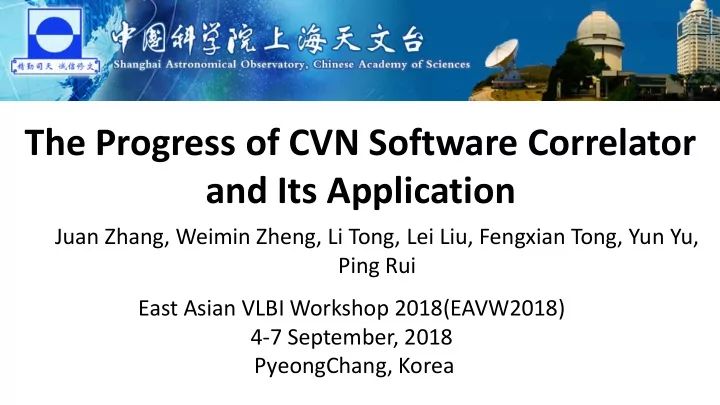

The Progress of CVN Software Correlator and Its Application Juan Zhang, Weimin Zheng, Li Tong, Lei Liu, Fengxian Tong, Yun Yu, Ping Rui East Asian VLBI Workshop 2018(EAVW2018) 4-7 September, 2018 PyeongChang, Korea
Outline 1. Background 2. The progress of CVN software correlator 3. The applications of CVN software correlator 4. Future work
Background CVN needs a general purpose software VLBI correlator: Deep-space, geodesy and astronomy • Deep-space probe tracking need special features: Real-time multiple objects processing (CE-5) Fast fringe searching and accurate delay model reconstruction GPU + CPU high speed software correlator. 3
Outline 1. Background 2. The progress of CVN software correlator 3. The applications of CVN software correlator 4. Future work
CVN software correlator structure PCAL extractor Station Shanghai Fringe NFS searcher Station Urmuqi Correlator Postprocess & Spacecraft delay configure file Output orbit Data preprocess model Station determination reconstruction Beijing Job file NFS Station Software Kunming correlation 5
CVN software correlator upgrade Update for the lunar mission: phase center 2 phase centers for two-probe same beam VLBI tracking Single object fringe search 4 objects fringe search GPU+ local correlation Phase reference VLBI FITS-IDI Specifications: Input format: Mark4/Mark5B/VDIF Output format: CVN/FITS-IDI/MK4 Graphical user interface Applications Probe phase referenced VLBI 6 IVS data processing MK4
Imaging results of DiFX and CVN software correlator Image of J0856+2111. (a) DiFX; (b) CVN SCORR Image of 4C39.25 . CVN scorr(red line), DiFX (black line) 7
Geodesy upgrade: output format CVN--> Mk4 • Platform:192 CPU cores cluster • 6 stations * 2.0Gbps/station • Convert output from CVN to Mk4 format • Fringe fitting with fourfit • Comparison with DiFX output using same observation sets (k14349, cn1502, apsg38) – Multi band residual delay (rate), SNR – Multi band total delay (rate), SNR 8
Difference between DIFX & CVN software correlator K14349 cn1502 apsg38 Data sources IVS CVN IVS Use same Y N N delay model S band MBD Y Y Y Difference < 10 ps X band MBD Difference Y Y Y < 3 ps SNR Difference Y Y Y < 0.5% Difference between DIFX and SCORR: S band MBD < 10 ps X band MBD < 3 ps SNR < 0.5% 9
Compare with K5:k14349 Delay compari riso son , X X band • IVS observation k14349 • Ny, Sh, Ts, Wz • 16IFs,8MHz/IF • 30scan Comparison Results : S-band X-band Delay <80 ps <13 ps Delay rate <1 ps/s <0.5 ps/s Confirms the two correlator results are consistent . 10
Outline 1. Background 2. The progress of CVN software correlator 3. The applications of CVN software correlator 4. Future work
Phase-reference VLBI results of CE-3 Lander • Target: CE-3 Lander, 2016-04-28 • Calibrator: 1936-155, 0.619JY, <2.5 ° • Stations: Kv (SEJONG), Kb(KASHIM34), Ho(HOBART26), Cd(CEDUNA), Hh(HARTRAO) • Valid Session Length : ~2h 12
CE-3 lander position results by 3 methods RA (deg) Dec (deg) Phase Reference -19.5076 44.1211 NASA LROC -19.5116 44.1214 CVN Lunar mission -19.5124 44.1206 Results difference Phase Reference – NASA LROC: ~122m (0.0040, - 0.0003) Deg Phase Reference – CE-3 mission: ~147m (0.0048, 0.0005) Deg Results keep consistent with each other well Need more observations to verify 13
Observation of GPS – 126b • Cd-Ho, Ceduna30m & Hobart26m • Residual time delay ~2ns , ~7m position accuracy • Session length ~2h • Bw=16MHz • 2016-05-05 Residual time delay VS. time 14
Observation of GPS-PG28 Auto-Correlation Spectral of SH & UR Cross-Correlation Spectral • SHANGHAI & URUMQI , Session length ~1.6h, Bw=8MHz • 2018-05-11 15
4. Future work • Lunar and deep space exploration mission • Geodesy and astronomy data processing CVN, IVS(VGOS), EVAN, AOV VGOS broadband ability 16
Thanks !
Recommend
More recommend